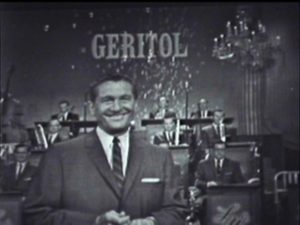DJB comments on his remembrance of Lawrence Welk.
For decades, I had been looking for ways to write about this three-year episode in my early-20s when, in my typically inside out ways, elder care lay at the heart of my life. In the autumn of 1992, the editors at The Baltimore Sun showed generosity by permitting me 800 words for a dance on their editorial pages. It was a good year for me, perhaps my most productive year in the old bookish sense of producing published work. Feeling emboldened, feeling like I could write any story I chose to write, I saw the 800 words as my first attempt to scratch the surface on a frozen lake, deep and wide. Maybe these 800 words, I thought, would lead me to a cold cracked opening, a passage back to my fading youth, a place where I could ruminate on what happened even as I watch it happen again. It didn’t work. The 800 ran on the Sun pages and moved on without me. But I didn’t give up, haven’t given up, and for the third or fourth time I’ve taken up the 800 again, here. Admittedly, this is not a finished work, but it’s three-times as long as originally written and slowly as I wedge in the 800 the crack is widening and I see watery visions of old people in nursing homes who are visited by a college student who gives them a television, free, out of nowhere, incredibly – and suddenly in the middle distance I hear coyotes howl. They’ve taken up residence right behind our home on the abandoned golf course. We’ve gotten so familiar with the varied coyote calls Erin and I have begun to identify some. This howl seems to be signaling a long story. – DJB.
He Gave Us the World as It Should Be
By Dennis Bartel
BALTIMORE SUN (May 29, 1992)
In the early 1970s while a college student, I worked as a research assistant for the Andrus Gerontology Center at USC, as part of a National Institute of Mental Health study called “Television: A Therapeutic Tool for the Aged.”
 The grand scheme of the study, of which I was only faintly aware, had something to do with designing in-house cable TV channels for life-care communities (old-age homes, as they were commonly known). Administrators could use their own in-house TV channel to communicate with and instruct their residents. Before any such TV Network for the Aged could be produced, our study sought to determine how people in old age homes used TV, which is to say, what they watched.
The grand scheme of the study, of which I was only faintly aware, had something to do with designing in-house cable TV channels for life-care communities (old-age homes, as they were commonly known). Administrators could use their own in-house TV channel to communicate with and instruct their residents. Before any such TV Network for the Aged could be produced, our study sought to determine how people in old age homes used TV, which is to say, what they watched.
We issued TV sets for six to ten weeks to subjects. If after six weeks the subject was providing a steady flow of watching an additional four weeks were added on, a reward for being a good subject. Each TV had a monitor device built into the back. I worked in the field, installing TVs and collecting data from monitors. This was often a grim chore. A large minority of our subjects were closing in fast on the end. Most seemed to be just waiting it out. They didn’t expect to go home, and they didn’t expect to wait long. Usually when I made my home rounds, hauling fifty-pound plastic TVs up and down disinfectant-reeking nursing home corridors and retirement centers stinking of smells I could never quite identify, a melange of odors, medicinal, floral, old skin, liquid soap, mashed food left too long on a tray, clumsily applied eau de toilet, and always, eventually, viscous excrement, I came upon subjects wearing the blank stare of the helpless and uninterested, sitting bedside in a wheelchair watching our portable color TV.
I’d say the men at the VA hospital were in the worst shape. One man I remember had been in the same ward since World War II. After he died (while watching TV, as the data revealed) $70,000 in cash was found stuffed inside his hollow wooden leg.
Such an anecdote comes from the anecdotal records I compiled for the study by interviewing subjects. I was expected to observe the subjects, get to know them, talk with the subjects, as much as each subject would allow, and record my findings, not only with a few stray remarks but I was also required in these anecdotal records to make an assessment of the subject’s “subjective age” – young or old – based on how they acted in relation to their chronological age, a tall chore for a 20-year-old undergrad in Telecommunications. For instance, here are a few of my entries in the study’s anecdotal records. Forgive me my prose as a young man who had yet to write much of anything. Please don’t laugh. I offer them to you in good faith.
WESTMINSTER GARDENS REST HOME
Junia Seybert (87): Poor Mrs. Seybert hardly had any of her original memory left, and things just drifted in and out of her mind in a most random fashion. She had deteriorated intellectually quite a bit. She did not remember me from week to week and it was only in the very end of the ten weeks that she began to show signs of recognition when I came into her room. She hardly ever used the TV, partly because she couldn’t remember how to turn it on and off and mainly because she had no interest in TV at all. Did not use TV Guide. Subjective age: old.
ST. JOHN OF GOD
John Bruchner (72). “Johnny” as the staff referred to him, has been mentally unbalanced since birth and has always been under some form of care. He was able to carry on a limited conversation and cared for most of his own vital needs. He was quite pleased with the TV though he did not understand the project. The first five weeks he occupied a room of his own and came and went as he pleased. The final week however, he was placed in a four-bed ward with three “vegetables,” as he called them when I came to take the TV. He did not use TV Guide. Johnny had greatly restricted reading skills. In fact, for weeks I noticed a beginning level reading book by his beside called “Tell a Joke.” Subjective age: old.
WOODRUFF CONVALESCENT
Patra Wadholm (77). Ms. Wadholm was at first very reluctant to turn the TV on for fear of radiation. However with each visit we talked more and she no doubt felt more at ease. I found her very charming and easy to talk to, and on occasion she would have me try on items she had knitted for a member of her family, a grandson, maybe two grandsons, I could never quite tell. She knitted constantly. There was apparently at first some resentment on the part of the roommate, Amanda Pennick (79), over Ms. Wadholm having received the TV and Ms. Pennick not having one. After Ms. Wadholm’s termination as a subject after six weeks, Ms. Pennick was given the TV and the two subjects bonded over it and continued to share the TV another forty weeks. Limited use of TV Guide. Subjective age: young.
ACACIA APARTMENTS
Chester Ryan (85). Mr. Ryan was the only male at Andrus Apts., and he took full advantage of the situation. He is single, he never married, and he was the individual most in demand at the Apts.’ games, meals, activities, etc. Mr. Ryan is very proud of his past. He once showed me his huge collection of picture albums which dated back to 1910. He still recalls minor details about events which took place long ago. A favorite story of his is about how he once flew with Lindbergh in the “Spirit of St. Louis” before his Atlantic trip. His cousin, T.L. Ryan has built a large corporation which among other things deals in aviation. Mr. Ryan enjoyed the TV but used it sparingly because he was usually visiting. He said he never wanted to inconvenience anyone. Upon our placing the TV with him the volume was not quite loud enough for hm to hear clearly. So he turned his hearing aid up so high I could hear its high pitched motor-device from across the room. Mr. Ryan then commented that the volume was now fine and there was no need for me to worry. Subjective age: young.
The Ph.D.s were concerned for their research. They needed to guard against our subjects leaving the TV on without actively watching. So the study’s tech-guy, Garth Reese, equipped each TV with a “perturbator” which caused the TV to go off every 15 minutes. In order to continue watching, the subject had to turn the TV back on by a remote control which was attached to the TV by a long cord. I quickly learned the perturbator was the source of mental anguish for many subjects.
“Something’s wrong with your television,” said Lewis E. DeVoss (85), subjective age: old. “It’s broken! It keeps going off.”
“It’s supposed to do that,” I replied, as I would reply a thousand times more to other subjects.
“Supposed to? You make it do that? Why the hell would you make it do that?”
“To see if you are really watching.”
“By making it go off?”
“Yes,” I said, trying to smile, trying to engage my subject. “Mr. DeVoss, if you turn it back on we’ll know you’re watching.”
“Of course I’m watching. I have the television on and I’m sitting right in front of it. What else do you want?”
“We need to know if you, maybe, fell asleep while you were watching. Things like that.”
“But it goes off right in the middle of a show. I’ll be watching it and, just like that, it just goes off. Right in the middle of something. Could be the news. I have to get up and turn it back on again every time. Sometimes I just don’t bother.”
“Mr. DeVoss, why don’t you keep the remote control next to your chair?”
“By the chair? No no. That cord won’t reach that far. Or maybe it will but I don’t want a cord running across the room like that. I‘ll trip on it. This is ridiculous. When I’m finished watching I turn off the television.”
“Yes, but not everyone does that, like you do, Lewis.”
“You give me a television, then you make it go off with your machine. What kind of test is this? I don’t want a television that doesn’t work right.”
Some subjects never complained about the perturbator. Some told me they learned to live with it. For others, like Mr. DeVoss, for those aged people who became frustrated over their perturbating TVs beyond any frustration members of our senior community should be forced to endure (even for social science), I figured out how to turn off their perturbator. A pair of wire cutters helped. I made a note to adjust for this lack of a perturbator when at my desk at the Andrus Gerontology Center decoding the listening strip of coated paper which each week, while visiting “congregate living facilities” (the study’s new replacement for old-age homes), I extracted from the back of the TV while chatting up the subject for more anecdotal data. For Mr. DeVoss, I discovered that with or without our perturbator his viewing habits remained the same.

The study lasted three years. According to the two Ph.D.s, the subject population grew to be statistically significant. It included dozens of congregate living facilities in several sections of southern California from Long Beach to Pomona, San Diego to Ojai, and cut across most broad lines of social class, education level, race and physical impairment. The only two constants were age (all subjects were over 65) and living circumstances (they all lived among other old people).
What did they watch? News. They watched news in far greater percentages than did their counterpart seniors in the general population, as measured by Nielsen. Local news, national news, it didn’t matter. The news programs they watched depended mostly on the congregate living facility’s meal schedule. If the subject was expected in the dining room at 6, he or she (overwhelmingly she) watched the news at 5, and vice versa. Very few subjects watched the 11 o’clock news.
This was encouraging data for us researchers. It somehow seemed to lend importance to our study. It suggested that residents in old-age homes, despite the blank stares I so often encountered, were still keenly interested in the world. It lent promise to the future of in-house TV info-networks for the aged and ill.
Except for one finding. At the top of the list of favored programs was Memories With Lawrence Welk. Where the top-rated news program was watched by 19.5 percent of our subjects, Lawrence Welk was watched by 30.3 percent. The show’s equivalent Nielsen figure was 9.6.
In every congregate living facility, from the upscale retirement community with an apartment for most residents and a nine-hole pitch and putt, to the short-term care nursing home with stained yellow tile floors in the hallways, from the cozy suburban convalesce hospital filled with people talking of when they were going home or to go live with a daughter and her husband, to the VA, it was the same. Saturday night at 7:30 was reserved for Lawrence Welk and his “champagne music,” for the famous Lennon Sisters, for the talented “Champagne Lady” Norma Zimmer, for polkas and inspirational songs.
 Having only recently emerged from an infatuation with Alice Cooper, I had no way of understanding what our geriatric subjects saw in Lawrence Welk. At the time, I prided myself at not ridiculing their viewing preferences, but I admit I was a little concerned that our long and expensive study might be trivialized in the eyes of the National Institute of Mental Health for having made the “wunnerful” discovery that old people watched Lawrence Welk.
Having only recently emerged from an infatuation with Alice Cooper, I had no way of understanding what our geriatric subjects saw in Lawrence Welk. At the time, I prided myself at not ridiculing their viewing preferences, but I admit I was a little concerned that our long and expensive study might be trivialized in the eyes of the National Institute of Mental Health for having made the “wunnerful” discovery that old people watched Lawrence Welk.
Now, with the passing of the old TV maestro, I’ve revisited the final narrative report of our study, and the anecdotal records I collected. Then as now, I’m no scientist, but it seems to me subjects in our study watched Lawrence Welk for some very particular reasons.
CONNORS HILL RETIREMENT CARE
Delores Shields (79), subjective age: old. “Most of what’s on TV I have trouble watching. It upsets me, makes me nervous. But I like ‘LW’ – it brings back lots of memories.”
GOOD SHEPHERD MANOR HALL
Clarence Low (69), subjective age: old. Mr. Low is recovering from a broken hip. Of Lawrence Welk he said, “They don’t write music like that anymore.”
And what music? There was New Orleans jazz trumpeter Al Hirt, who got his start in big time show biz on The Lawrence Welk Show performing with clarinetist Pete Fountain. There was Gail Farrell, pianist and vocalist who honed her chops at rodeos, and in the Miss Oklahoma Beauty Pageant she won the talent and swimsuit competitions. At 22, Farrell joined The Lawrence Welk Show, on which she performed many duos as pianist, and as part of a trio with Michael Redman and her husband Ron Anderson. There was the lounge-singing wife-husband duo Ralna English and Guy Hovis who went from The Horn, a Santa Monica nightclub, to The Lawrence Welk Show and remained there a few years until 1980 when they separated and Ralna suffered, as she called it, “a nervous breakdown.” There was Kenny Trimble, trombonist who played in Lawrence Welk’s band twenty-five years, including sixteen as first bone.
I am left to wonder now if maybe our subjects watched the news to see the world as it is, and Lawrence Welk to see the world as it should be.
That’s why the death of Lawrence Welk, whose dowdy music, hokey wholesomeness and bubbles I could never abide, now seems more important than I ever thought it would.
Last Sunday I tuned into the Lawrence Welk rerun on public television, and I was glad when the smiling maestro raised his baton: “And-a-one, and-a-two . . .”
